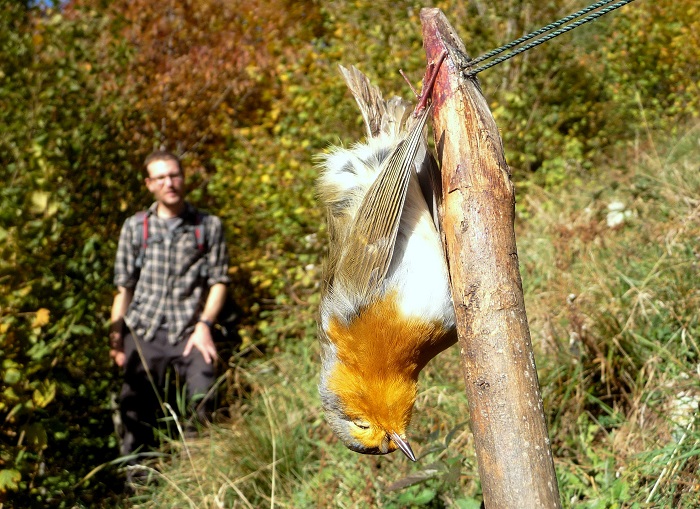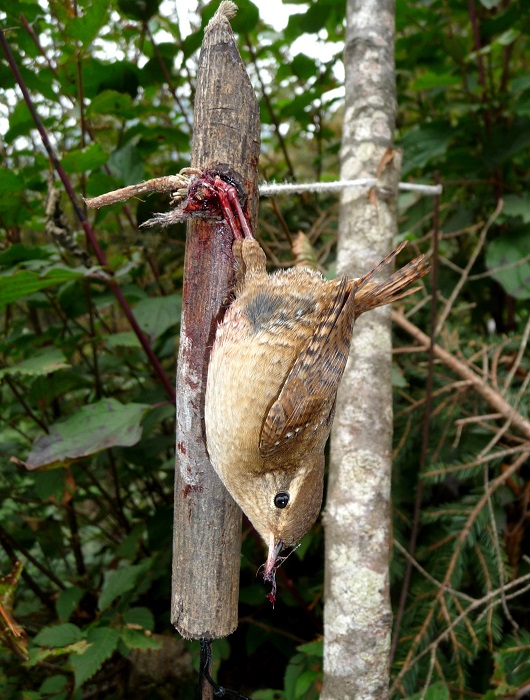Robin caught in a bow trap ('archetti') in northern Italy

The mechanics of the bow trap, which at first glance looks quite simple, are astonishing and extremely brutal: a small stick and a string keep the bow, which is traditionally made of a hazelnut rod (today mostly wire), under tension. Birds are attracted by rowan berries and are tempted to settle on the horizontally mounted stick. When they touch it, the bow rushes apart. In just a fraction of a second, the birds hang upside down with their legs completely crushed in the noose. This way the birds stay 'fresh' for a long time even in the warm autumn sun and are only dispatched by the bird trapper after hours of agony. Some, however, also die from blood congestion in the head, general cardiovascular failure or simply bleed to death.
Robins make up about 90% of the birds trapped with bow traps. Among the remaining 10 % there are mainly song thrushes, wrens and goldcrest, more rarely brambling and chaffinches, titmice and large birds such as long-eared owls or jays get caught. Occasionally, dormice and hazel mice also die in the traps.

History shows that Bow traps were in use as far back as the Bronze Age and were common in almost all European countries until the beginnings of the Modern Age. In Germany, where the traps were called "Sprenkel", they were banned in the 19th century and found for the last time in the years just before the 1st World War.
Since then the brutal traps have disappeared from the forests of Europe, with one exception: Brescia, situated between Lake Garda and Lake Iseo in northern Italy.
In the mid-1980s of the 20th century, the archetti traps were still visible to everyone in the front gardens in the mountain villages of the province of Brescia. The traps could also be seen along hedgerows, pastures and meadows from roads and hiking trails, even though they had been banned in Italy for more than 100 years.
During the Committee's first Brescia mission in 1983, six activists collected 3,266 bow traps in two days! Since then, the camps have become longer and longer - those initial somewhat spontaneous trap collecting missions have matured into well-organised 'bird protection camps' with hundreds of participants within the last 15 years. The number of bow traps found during the missions increased up to and including 2001 with the ever more extensive operation. In 2001 a total of 71 people were involved in the Committee Against Bird Slaughter (CABS) bird conservation camp, searching for traps for over two and a half weeks - they found a whooping 12,104 bow traps!
In the subsequent years, cooperation was agreed and took effect for the first time in 1999. Instead of dismantling the traps, we led the officials to the trapping sites, so that they could ambush and catch and convict the poachers red-handed! Each autumn more than 50 poachers were quickly nabbed - the fear of the bird trappers was evident in the number of bow traps found in 2002: There were only 9,500 bow traps left. To date, the number of bow traps has continued to fall drastically. In autumn 2007 we still found 1,320 traps, in 2012 we were able to drop below the "magic" limit of 1,000 for the first time with 963 traps, in 2018 it was only 392, autumn 2023 we collected 269 and so far this year we are yet to find a single one!
Not only the number of traps has changed, but also the "trapping season". Because of the constant danger of being caught, bird trappers today only use the core time of bird migration. The traps no longer stand set for three months in autumn, as they used to, but only from the beginning of October to mid-November!






